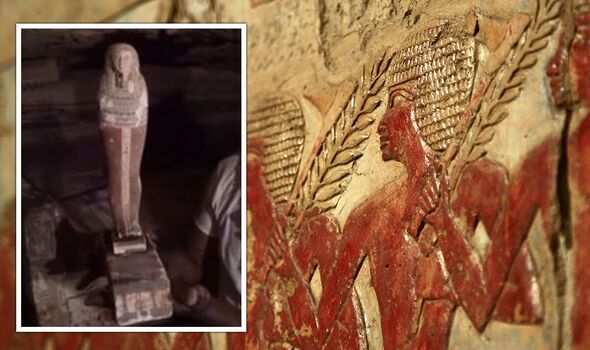Egypt has, throughout the years, unveiled some of the most coveted and promising archaeological treasures.
Commencing in the mid-1880s, excavations in the North African nation commenced under the guidance of William Matthew Flinders Petrie, the esteemed English Egyptologist often hailed as the “father of Egyptian archaeology“.
Since then, archaeologists and scholars have been drawn to Egypt, diligently exploring and scrutinizing every inch of terrain believed to conceal secrets of antiquity.
It might seem incredulous that after over a century of excavations and plundering, Egypt still harboured undiscovered relics.
Nevertheless, each year brings forth a plethora of ancient artefacts.
One remarkable discovery of a previously unknown tomb was chronicled in the Smithsonian Channel’s documentary, ‘Tomb Hunters’.
In it, archaeologists ventured into Saqqara, where a trove of statues and other relics emerged in 2020.
Numerous “priceless treasures” were unearthed, attesting that the tomb’s occupants were “exceptional” individuals of their era — many of these artefacts dating back up to 2,500 years.
Among them was a statue, believed to be a protective talisman for the departed, boasting a perfectly preserved gilded visage. These statues were interred alongside the deceased as tokens and symbols of fortune for their journey into the afterlife.
The narrator remarked: “These invaluable treasures shed light on how the burial practices of wealthy Egyptians evolved during the late period — becoming increasingly commercialised.”
Ancient Egyptians held profound concerns about their transition into the afterlife, meticulously consulting the Book of the Dead for guidance and sparing no effort for their departed kin.
Dr Mohammad Youssef, overseeing the excavation, remarked: “The process of mummification and burial is primarily a religious endeavour, but it also involves commerce.
“Numerous individuals were engaged in this endeavour. Carpenters, traders, artisans crafting statues, priests, guards, and those managing the mummification process—all partook in this enterprise.”
The excavation team delved deeper into the burial chamber, hoping to uncover further revelations. They soon encountered coffins stacked upon coffins, filling every available subterranean space.
The narrator observed: “What began with a solitary coffin has transformed into a vast tomb housing over 100 coffins.”
Katharina Stövesand, an Egyptologist, remarked: “The burial of these individuals necessitated a monumental effort.
“These coffins epitomize how Saqqara operated as a thriving death industry, with the deceased as its clientele. Saqqara boasted a thriving funerary industry and served as a lucrative venture.
“We are aware that spaces within tombs were sold, mummification services were offered, and priests conducted rituals — all of which incurred significant expenses.”
The mega-tomb swiftly emerged as the largest concentration of coffins ever discovered in Egypt, eclipsing any previous findings by threefold.
